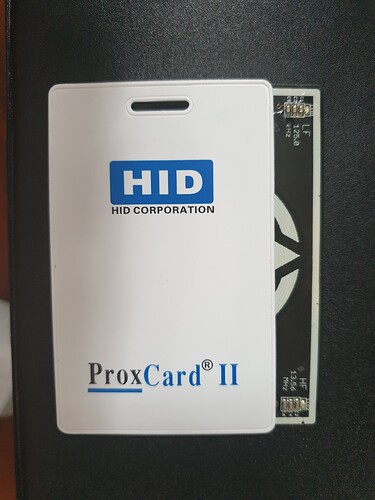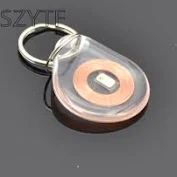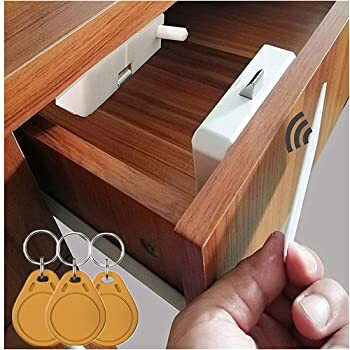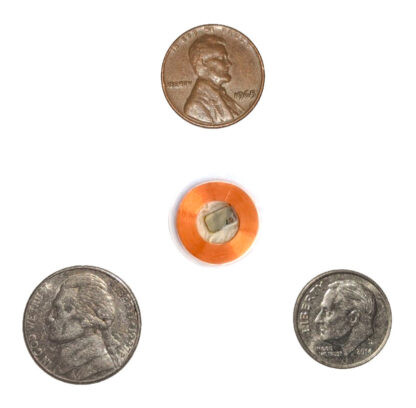Hey,
about one week ago I implanted the NExT in my right hand. The NFC chip works just fine, but I’m not able to detect the 125KHz chip. I tried several different reader without any luck. Is it possible that I got a bad NExT implant on which the T5577 isn’t working?
What are you trying to read it with?
I tried the little blue handheld device from Dangerous Things and several reader at work from which I don’t know the name. I got the NExT mainly for the NFC chip, but I was kind of hoping I could use the T5577 as access for work because they’re using those in their badge cards. However, nothing is able to detect the T5577 in the NExT implant, but the NFC part works like a charm. I guess I get a separate LF implant which I can use as key for work.
It is a T5577 but should be in EM mode, The Blue cloner will read and write to it, However, there are a few LF systems that the Blue cloner cant do, but a proxmark for example can.
There are also some LF systems that just don’t play nice.
Can you share some more information about your work system?
A photo of any markings on the card
A photo of the reader(s) at your work.
All is not lost, we just need some more info to help you out
Just to confirm, how do you know your work uses LF?
Did you use you diagnostic card and / or the x Field detector keychain?
Just as an aside
Make sure you read the potential pitfalls of the blue cloner before you start trying to write to it
I still plan to add one at some point to the tool box, but I will be doing rosco’s antenna coil mod
I tried the “Blue Cloner” on the card from work and it worked(at least it beeped). I’m not planning on getting a proxmark3 for that because the T5577 in the NExT is just secondary. The x Field detector keychain is a good idea and I’ll try this today on my way out(I have to be careful because they have cameras everywhere on the gates). It probably would look somewhat suspicious if I pull out the diagnostic card by the gate.
There’re no markings on the badge cards, just plain white plastic cards with printed information on it(like your photo, name, ID-Number, authorized access area code and the usual stuff)
Thank you for the tip, I heart about the issues with the “Blue Cloner”. What is the “rosco’s antenna coil mod”?
In a nut shell, popping the antenna out of the housing and changing its orientation to work a little better with implants
This is better for when you have the ability to play at the reader a bit longer
SO
THIS IS WHAT I WOULD DO
Just present as normal, but you should see, one ( Or both of the LEDs, light up )
@Eriequiet I just took my “Blue Cloner” apart and played with the antenna. When I place the antenna directly onto the skin above my implant it can detect the T5577. I also can read my batch card from work, but I’m a little skittish to write to my implant with that “Blue Cloner”.
@Pilgrimsmaster Hey good idea with the diagnostic card, I’m going to give it a shot in the morning.
Skittish is good,
Watch the video Amal posted about it
Once you know you are getting a good read, then you can try writing
@Eriequiet gave you so great links with good info, tips & tricks.
The other side to it, and what may be causing you some trepidation; the Blue cloner forcibly writes a password onto the chip.
If you only want to write to that chip with the blue cloner, then it doesn’t really matter, If you ever want to write outside of EM,HID, AWID you will need a Proxmark to remove the password and write whatever else you wanted to.
So it is not a major issue, But just something you need to be aware of.
Today I tried the diagnostic card on the gate at work and I have to say I’m confused. The HF-LED did light up even the cards must be LF cards. I can read them with the “Blue Cloner” and not with the “KBR1 RFID Reader”, which makes me assume the cards are 125KHz.
I guess I need to investigate a little deeper into this.
Wouldn’t be a surprise to have a dual frequency reader with lf card most companies install them to either future proof ![]() or upgrade existing infrastructure but don’t issue new tags to current employees just to new staff
or upgrade existing infrastructure but don’t issue new tags to current employees just to new staff
Hi all,
I actually came to the forum today with the same sort of issue. I’ll just add my comments here rather than creating a new thread. I’ve had the xEM for about 5 years and use it daily. A few weeks ago I had a NeXT installed and I have to say the read range on the T5577 is abysmal compared to the xEM. I thought originally that it was just the swelling/bruising/edema from the installation that was decreasing read range, but my hand is just about back to normal and the injection site is almost 100% healed. I still struggled to get a read and write with my blue cloner. I also picked up the lock below for use on my gym locker and I’ve REALLY got to fidget with orientation/placement with the antenna touching my hand to get a read and open. No chance I’ll get a scan through a wooden door. I guess at this point I’ll play with the chipset on the lock a bit and try to over-drive the antenna, but I wondered if anyone else has the xEM and the NeXT and has experienced this variance in chip activation within the same antenna/field?
Edit: Forgot to add the lock link.
https://www.amazon.com/gp/product/B08KDTPZCN/ref=ppx_yo_dt_b_asin_title_o05_s00?ie=UTF8&psc=1
I think you’re right the reading range of the T5577 in the NExT implant really sucks. I even think the range for the NTAG216 is limited too. That’s probably the price you have to pay if you put two chips in a container which is designed for one.
Any swelling/bruising/fluids are going to affect read range.
Also the depth, the location, orientation are all going to affect your results.
Let’s wait until it IS 100% before making a comparison.
Compared to a full-sized card, compared to a fob, compared to a flex implant???
Yeah, sure…But
I think we might need to take a step back and recalibrate our expectations.
What you guys are complaining about are very small, glass and resin encapsulated chips with ferrite rods, and a wound antennas, and you are expecting the same /similar results as a full sized card/fob.
It’s all about physics my friends
If you want the range and performance it sounds like you expect, you need to look at getting a FlexEM, a FlexMT, a FlexMN …These are larger and flatter antennas, with a design more closely related to couple with a flat reader antenna.
If you were to open up a fob or key card, you will see the same antenna design
This fob is pretty much the Flex EM
This card is pretty much the equivalent version of the NExT…
Circle = LF T5577 Rectangle = HF NT216
If range is what you want, get a Flex!
Same answer goes for above.
If anything, it should be the other way around. The LF should have slightly better range, but we are talking millimeters ![]()
Indeed, however you could consider routing out the back of the door and countersink your lock, or get a Flex…
Do you see the fobs it comes with??? If you want the same performance, get the fob equivalent, The FlexEM
NOPE, YOU ARE INCORRECT, It is specifically designed, manufactured and made for the 2 chips.
Here are some more videos to help explain further
Yeah, I think we need to do some more digging.
It sounds like you have to be discreet, so on your door readers, are there any markings, logos, words, colours?
Are all the readers the same?
Can you “google” to find us an image?
Like @Devilclarke said above, quite possibly it is a Dual Freq. reader.
You mentioned the HF LED of the Diagnostic card lit up, but didn’t mention the LF LED…
Did that light up also?
I’m still a little unsure what is going on, especially with he KBR1 reader not working, I am thinking either faulty reader or the Card is a ISO15693 (the KBR1 only reads ISO14443A)
Let’s do some more testing.
Can you do me a favour, could you download Taginfo by NXP ?
Scan your access card, and let us know if you get any results ( feel free to hide the ID )
Chances are you have a dual frequency CARD (or fob) and the reader on the door is HF and reading the HF chip in your source device. Try scanning your card or fob with an NFC capable smartphone and TagInfo. The HF component of the card may be operating ISO15693 or possibly a fudged up Legic HF card… something the KBR1 will not be able to read, but an NFC phone should be able to.









